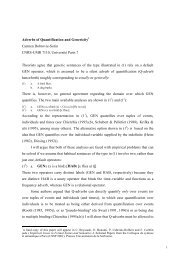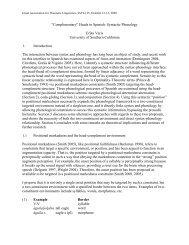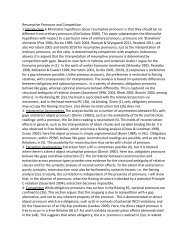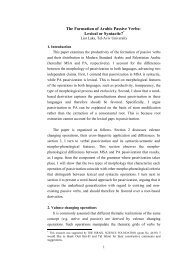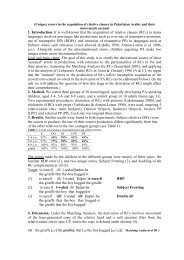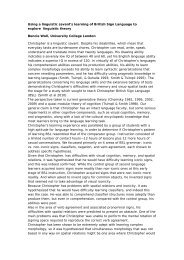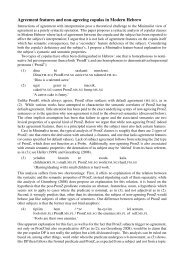paper
paper
paper
Create successful ePaper yourself
Turn your PDF publications into a flip-book with our unique Google optimized e-Paper software.
3 NP-NP and NP-PP Coordination Hypotheses<br />
The next question is whether comitative and ordinary coordination have the same syntactic<br />
structure. From the data discussed so far, it is natural to assume that ordinary and<br />
s-coordination are the same, since their behavior seems to be identical. However, the existence<br />
of a special form of conjoining two NP’s might hinge on the existence of a different<br />
syntactic structure. In this section, I will explore the two possible hypotheses.<br />
3.1 Dyła 1988<br />
One of the most natural assumptions to make with respect to s-coordination is to assume<br />
that it is exactly the same as ordinary coordination, or at least very similar.<br />
Dyła (1988), who considers an analogous phenomenon in Polish, treats comitative constructions<br />
that trigger plural verb agreement as ‘quasi-comitative’; i.e. they look like comitative<br />
constructions but exhibit the syntactic properties of coordinate constructions. Dyła’s<br />
main argument is the fact that both ordinary and comitative coordination 2 triggers the plural<br />
agreement with the verb. Dyła (1988) argues that comitative coordinate phrases (‘quasicomitative<br />
constructions’) are indeed coordinate constructions. Consider the following Polish<br />
example Dyła (1988):<br />
(17) Ewa<br />
nom.fem<br />
z<br />
with<br />
Jankiem<br />
instr.masc<br />
poszli<br />
went-3pl.masc<br />
Eve and John went for a walk.<br />
na<br />
for<br />
spacer.<br />
walk<br />
This comitative construction is analogous to the Russian examples discussed in the previous<br />
sections. The difference is that in Polish the picture becomes more complicated due to<br />
gender agreement. Only nominative-marked NPs can be controllers of gender agreement<br />
in Polish. When no NP meets this requirement, the verb is in its third neuter form. In<br />
sentences with a controller, the verb agrees with the controller.<br />
Dyła offers a GPSG analysis of these constructions. He analyzes the NP-z-NP string as<br />
an instance of coordination of two NPs, one of which looks like a PP. He makes this assumption<br />
on theory internal grounds. On his analysis, masculine is a default value for the<br />
feature [GENDER] on a human or animate NP. The value for [GENDER] of the NP in the<br />
z-NP string contributes to the value for [GENDER] on the mother node, otherwise it will<br />
be impossible to provide a systematic account of gender resolution in quasi comitatives.<br />
In order to make this idea work, Dyła treats z neither as a conjunction, nor as a full-fledged<br />
preposition. The z-phrases are rather NPs with proclitic prepositions. He provides a number<br />
2 Here and in the further discussion of McNally (1993), I am using the term ’comitative coordination’<br />
instead of s-coordination to preserve the original terminology of the authors.



